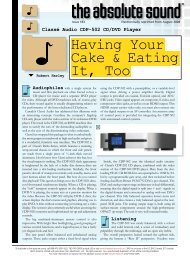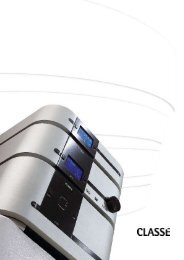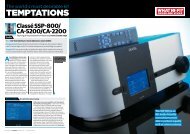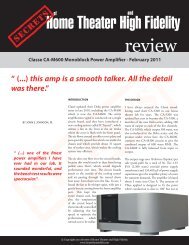Owner's Manual CA-5200 Power Amplifier - Classé Audio
Owner's Manual CA-5200 Power Amplifier - Classé Audio
Owner's Manual CA-5200 Power Amplifier - Classé Audio
You also want an ePaper? Increase the reach of your titles
YUMPU automatically turns print PDFs into web optimized ePapers that Google loves.
Owner’s <strong>Manual</strong><br />
<strong>CA</strong>-<strong>5200</strong><br />
<strong>Power</strong> <strong>Amplifier</strong>
WARNING: TO REDUCE THE RISK OF FIRE OR ELECTRIC SHOCK, DO<br />
NOT EXPOSE THIS APPLIANCE TO RAIN OR MOISTURE.<br />
<strong>CA</strong>UTION<br />
RISK OF ELECTRIC SHOCK<br />
DO NOT OPEN<br />
<strong>CA</strong>UTION: TO REDUCE THE RISK OF ELECTRI<strong>CA</strong>L SHOCK, DO<br />
NOT REMOVE COVER. NO USER-SERVICEABLE PARTS INSIDE.<br />
REFER SERVICING TO QUALIFIED PERSONNEL.<br />
The lightning flash with arrowhead symbol, within an equilateral triangle, is intended to alert the<br />
user to the presence of uninsulated dangerous voltage within the product’s enclosure that may be of<br />
sufficient magnitude to constitute a risk of electric shock to persons.<br />
The exclamation point within an equilateral triangle is intended to alert the user to the presence of<br />
important operating and maintenance (servicing) instructions in the literature accompanying the<br />
appliance.<br />
Marking by the “CE” symbol (shown left) indicates compliance of this device with the EMC (Electromagnetic<br />
Compatibility) and LVD (Low Voltage Directive) standards of the European Community.<br />
NOTICE<br />
All of us at Classé take extreme care to ensure that your purchase will remain a prized investment. We are proud to inform you that<br />
all Classé components have been officially approved for the European Community (CE) mark.<br />
This means that your Classé product was subjected to the most rigorous manufacturing and safety tests in the world. The CE mark<br />
certifies that your purchase meets or exceeds all European Community requirements for unit-to-unit consistency and consumer<br />
safety.<br />
The information contained in the manual is subject to change without notice. The most current version of this manual will be<br />
posted on our web site at http://www.classeaudio.com.<br />
2
Important Safety Instructions<br />
Caution:<br />
Please read and observe all warnings and instructions in this owner’s manual and all those<br />
marked on the unit. Retain this owner’s manual for future reference.<br />
1. Do not attempt to service this product yourself. Do not open the cover for any reason. There are no<br />
user-serviceable parts inside. An open unit, particularly if it is still connected to an AC source, presents<br />
a potentially lethal shock hazard. Refer all questions to authorized service personnel only.<br />
2. To prevent fire or shock hazard, do not expose the unit to water or moisture. If a liquid does enter<br />
your component, immediately disconnect it from the AC mains and take it to your Classé dealer for a<br />
thorough check-up.<br />
3. Do not place your component near any heat-producing device such as a radiator, stove, etc., Keep<br />
it away from direct sunlight.<br />
4. Connect your component only to an AC source of the proper voltage. The shipping container and<br />
the rear panel serial number tag will indicate the proper voltage. Use of any other voltage may damage<br />
the unit and void the warranty.<br />
5. AC cords should be routed so that they are not likely to be walked on or pinched by items<br />
placed upon or against them. Do not stress the AC cord by stretching it to reach a plug. If damage<br />
does occur to the AC cord, take it to your Classé dealer for a thorough check-up and proper repair or<br />
replacement.<br />
6. If your component will be out of use for an extended period of time (vacation, etc. ), you may wish<br />
to unplug the power cord from the AC source to prevent any chance of problems from a voltage surge<br />
or lightning strike.<br />
7. NEVER wet the inside of this product with any liquid.<br />
8. NEVER pour or spill liquids directly onto this unit.<br />
9. NEVER block air flow through ventilation slots or heatsinks.<br />
10. NEVER bypass any fuse.<br />
11. NEVER replace any fuse with a value or type other than that specified.<br />
12. NEVER attempt to repair this product. If a problem occurs, contact your Classé dealer.<br />
13. NEVER expose this product to extremely high or low temperatures.<br />
14. NEVER operate this product in an explosive atmosphere.<br />
15. ALWAYS unplug sensitive electronic equipment during lightning storms.<br />
Please record the serial number of your new Classé component here for future reference.<br />
Serial #: __________________<br />
3
Contents<br />
Welcome to the Classé family ..........................................................................5<br />
a word about installation .......................................................................... 5<br />
Unpacking and Placement ...............................................................................6<br />
unpacking your amplifier ......................................................................... 6<br />
placement ................................................................................................ 6<br />
ventilation ................................................................................................ 6<br />
custom installations .................................................................................. 7<br />
serial number ........................................................................................... 7<br />
register your purchase! ............................................................................. 7<br />
operating voltage ...................................................................................... 7<br />
warm up/break-in period .......................................................................... 8<br />
please read this manual… ........................................................................ 8<br />
highly refined circuit design ..................................................................... 9<br />
extensive listening tests ............................................................................ 9<br />
extraordinary longevity .......................................................................... 10<br />
robust protection .................................................................................... 10<br />
Front Panel .....................................................................................................11<br />
Rear Panel .....................................................................................................13<br />
Initial Setup ...................................................................................................17<br />
configuring balanced/single-ended operation .................................. 17<br />
configuring amplifier turn-on delay/amp no. .................................... 18<br />
Care and Maintenance ...................................................................................19<br />
Troubleshooting .............................................................................................20<br />
Specifications ................................................................................................22<br />
Dimensions ...................................................................................................23<br />
4
Welcome to the Classé family<br />
Congratulations on your purchase of a Classé product. It is the result of many<br />
years of continuous refinement, and we are sure that you will enjoy it for many<br />
years to come.<br />
We value our relationship with our customers. Please allow us to stay in touch<br />
with you by returning your warranty card now, before you pack up the shipping<br />
carton of your new product and forget all about it. Doing so will enable us to<br />
let you know about any possible future upgrades or updates that might become<br />
available for your Classé component.<br />
Sending in your warranty card also registers your product with us so that<br />
warranty service can be obtained easily and quickly, even if you have mislaid<br />
your original sales slip.<br />
Please, take a few minutes to fill out the warranty registration<br />
card, and drop it in the mail.<br />
You will find the warranty registration card at the end of the separate warranty<br />
policy booklet, enclosed.<br />
a word about installation<br />
Every effort has been made to make the Classé <strong>CA</strong>-<strong>5200</strong> simple and<br />
straightforward to install and use.<br />
Still, we have no way to evaluate many other variables such as the size and shape<br />
of your room, its acoustics, and the associated equipment you have chosen to use<br />
with your amplifier. All of these factors influence the ultimate performance of<br />
your system.<br />
For this reason, we strongly encourage you to have your system<br />
installed and calibrated by your dealer, whose experience,<br />
training, and specialized equipment can make a profound<br />
difference in the final performance of the system.<br />
5
Unpacking and Placement<br />
unpacking your amplifier<br />
Carefully unpack your power amplifier according to the supplied instructions,<br />
and remove all accessories from the carton. Please take care when lifting the<br />
amplifier, as it is quite heavy.<br />
Important!<br />
Keep all packing materials for future transport of your Classé<br />
product. Shipping your new component in anything other than<br />
its purpose-designed packing material may result in damage<br />
that is not covered by the warranty.<br />
placement<br />
There are two options when placing your power amplifier: you may place it close<br />
to the speakers, requiring longer interconnecting cables from the preamplifier; or<br />
place it close to the preamplifier, requiring longer speaker cables.<br />
Although either approach will yield excellent performance, you might consider<br />
the first option for two reasons. First, signal quality degrades more easily when<br />
transmitted as a combination of both high voltage and high current, suggesting<br />
that speaker cables should be kept as short as practical. Second, high quality<br />
amplifiers use massive power supplies which inevitably radiate some degree of<br />
magnetic fields. Ideally, one would separate these fields from sensitive source<br />
components by a reasonable distance.<br />
If it is more convenient for you to place the amplifier in an equipment rack,<br />
along with your other components, we suggest placing it at the bottom of the<br />
rack, well away from your source components and preamplifier. This location<br />
will also be more stable than placing such a heavy component near the top of a<br />
rack, which might make it top-heavy.<br />
Note that adequate clearance for the AC cord and connecting cables<br />
must be left behind the <strong>CA</strong>-<strong>5200</strong>. We suggest leaving eight inches<br />
(20 cm) of free space behind your power amplifier to allow all cables<br />
sufficient room to bend without crimping or undue strain.<br />
ventilation<br />
Your Classé power amplifier generates a certain amount of heat in the course<br />
of normal operation. Be sure to allow six inches of clearance above it and<br />
three inches to each side to allow heat dissipation through air circulation. The<br />
vents on both the bottom and the top of the <strong>CA</strong>-<strong>5200</strong> must be kept free from<br />
any obstruction which would reduce the flow of air through the unit. Avoid<br />
placement on soft surfaces that would restrict airflow (such as plush carpeting).<br />
6
custom installations<br />
Drawings are included in this manual to facilitate special installations and<br />
custom cabinetry (see the section Dimensions). An optional, purpose-designed<br />
rack mount kit is available for this product. Contact your Classé dealer for more<br />
information.<br />
serial number<br />
The serial number for your power amplifier is found on the rear of the unit.<br />
Please note and record this number on the page entitled Important Safety<br />
Instructions for your future reference.<br />
register your purchase!<br />
Having found the serial number, now would be a good time to fill out the<br />
registration card. Please register your purchase so we can advise you of updates<br />
and other items of interest.<br />
It will take only a minute or so. Please complete the card now, before you forget.<br />
operating voltage The <strong>CA</strong>-<strong>5200</strong> power amplifier is set at the factory (internally) for 100V, 120V,<br />
230V, or 240V AC mains operation, as appropriate for the country in which<br />
it is to be sold (230V only in European Union countries, in compliance with CE<br />
regulations). The voltage setting may not be changed by the user or dealer.<br />
Make sure that the label on the rear panel of your power amplifier indicates<br />
the correct AC operating voltage for your location. Attempting to operate your<br />
power amplifier at an incorrect voltage may damage the unit.<br />
Warning:<br />
The voltage setting of your power amplifier may not be changed<br />
by the user. There are no user-serviceable parts within the<br />
unit. Please refer any problems to an authorized Classé service<br />
center.<br />
If the AC mains voltage indicated on your power amplifier is incorrect, please<br />
contact your local, authorized Classé dealer or distributor.<br />
The <strong>CA</strong>-<strong>5200</strong> can easily be powered by a normal 15-ampere AC mains line. If<br />
other devices are also powered from the same AC line, their additional power<br />
consumption should be taken into account.<br />
7
The <strong>CA</strong>-<strong>5200</strong> includes protection circuitry that will prevent the amplifier from<br />
operating at dangerously high or low voltages.<br />
• At startup: the AC mains voltage must be within a range of<br />
approximately -15% to +10% of its nominal value at startup, or<br />
the amplifier will not turn on. For example, a 120V unit requires<br />
the AC mains to be between approximately 95V–135V in order to<br />
turn on.<br />
• Over-voltage during operation: if the AC mains voltage surges<br />
by roughly 10% or more during operation, the amplifier will enter<br />
protection mode and shut down. The Standby LED will flash to<br />
indicate the protection mode has been engaged.<br />
• Under-voltage during operation: if the AC mains voltage sags by<br />
15% or more, the amplifier will continue to play (since this does<br />
not present a particular danger to the amplifier), but note that<br />
it may not be able to achieve its usual standard of performance<br />
under these compromised conditions. The Standby LED will<br />
flash to indicate the condition.<br />
warm up/break-in period<br />
Your new Classé power amplifier will deliver outstanding performance<br />
immediately. However, you should expect to hear it improve somewhat as<br />
it reaches its normal operating temperatures and its various components<br />
“break-in.” It has been our experience that the greatest changes occur within the<br />
first 300 hours, as the amplifier reaches thermal equilibrium and the capacitors<br />
fully form. After this initial break-in period, the performance of your new<br />
product should remain quite consistent for years to come.<br />
The only exception to this rule is if the unit is placed in standby or unplugged<br />
for an extended period of time, allowing it to cool down. Depending on the<br />
degree of cooling involved, you should expect a brief warm-up period before the<br />
power amplifier’s sound quality is at its best. Unless your amplifier was allowed<br />
to become quite chilled, subsequent thermal re-stabilization should not take<br />
long. Fortunately, you should never have to repeat the initial 300 hour break-in<br />
period.<br />
please read this manual…<br />
Please take a few minutes to review this manual, and to familiarize yourself with<br />
your new amplifier. We understand that you are anxious to plug everything in<br />
and get started. However, reading this manual and following the advice it gives<br />
will ensure that you get all the benefits you deserve from having purchased such<br />
a fine piece of equipment.<br />
8
Special Design Features<br />
highly refined<br />
circuit design<br />
All Classé analog amplification stages are based on circuits that have been<br />
extensively optimized over many years of continuous development.<br />
By starting with excellent circuit designs and working with them over the years,<br />
we are able to discover the many small refinements that add up to superlative<br />
performance, in a variety of applications. Altering a voltage here, or using a<br />
slightly different part there, may make all the difference between solid and<br />
absolutely outstanding performance.<br />
This level of refinement only comes with a great deal of experience, and is<br />
not available to those who flit from one trendy notion to the next. It accounts<br />
in no small measure for both the consistency of sonic performance among<br />
Classé products (as they are all based on similar analog gain stages), and for the<br />
consistently excellent reviews those products receive by owners and reviewers<br />
alike.<br />
extensive listening tests<br />
Excellent measured performance is to be expected in world-class products, and<br />
Classé products deliver that performance. However, experience has shown that<br />
technical excellence alone is insufficient to guarantee subjectively musical results.<br />
For this reason, all Classé products are laboriously fine-tuned during the<br />
development process by carefully controlled listening tests. Our ears are still<br />
some of the finest laboratory test instruments available, and nicely complement<br />
more traditional engineering test equipment. In the course of optimizing the<br />
circuitry for a product, hundreds of decisions are made based on the subjective<br />
impression given by substituting one high quality part for another.<br />
As an example, we may listen to half a dozen 0.1% film resistors of the same<br />
value, from several different companies. Standard tests may show them all to<br />
provide identical results in terms of noise, distortion, and so forth. Yet, almost<br />
invariably, one selection yields some small improvement in the subjective<br />
reaction to the performance of the product under development. Less often, even<br />
a single such change can result in a surprisingly large improvement.<br />
Multiply those various improvements by the dozens or even hundreds of such<br />
decisions that must be made before the product can be finalized for production,<br />
and you have a remarkable improvement, indeed—all based on careful listening<br />
tests, which we view as a necessary complement to the solid engineering you<br />
might rightly expect from Classé.<br />
9
extraordinary longevity<br />
Another benefit of having worked with highly refined circuit designs so<br />
extensively over many years is that we have vast experience in what works well<br />
over the long term.<br />
By using only the highest quality parts to begin with, and then using them in an<br />
informed way as a result of both accelerated aging experiments and actual longterm<br />
experience, we are able to design and manufacture products which we are<br />
confident will stand the test of time.<br />
We are confident that your new Classé product will give you many years of<br />
trouble-free reliability and musical enjoyment, just as previous Classé products<br />
have given their owners.<br />
robust protection<br />
Finally, your new Classé amplifier incorporates a variety of protection circuits, all<br />
designed to protect both the amplifier and your loudspeakers against dangerous<br />
fault conditions. Significantly, these protection circuits do not intrude upon<br />
or limit the normal performance of the amplifier; rather, they simply put the<br />
amplifier into protection mode when confronted with abnormal conditions.<br />
These conditions include:<br />
• output overload<br />
• DC offset<br />
• AC mains voltage (outside of normal tolerances)<br />
• excessive operating temperatures<br />
If any of the first three conditions occurs on either channel (any of which<br />
might harm either your amplifier or possibly your loudspeakers), the amplifier will<br />
immediately go into protection mode. In such a case, a Channel LED indicator<br />
will blink red, indicating the channel with the fault, and the sound will be<br />
muted until the fault can be righted.<br />
If the fault is not channel-related, e.g. AC mains voltage out of range, the<br />
Standby LED will blink. In all cases, the unit will need to be re-started once the<br />
cause of the fault condition has been rectified.<br />
10
Front Panel<br />
1 Standby button & LED indicator<br />
The front panel Standby button will toggle the amplifier between operate,<br />
its fully operational state, and a standby mode that leaves the amplifier off,<br />
yet ready to respond to system commands via any of the supported control<br />
options (e.g. IR input, DC trigger, <strong>CA</strong>N Bus, or RS-232).<br />
The current state of the amplifier is indicated by the LED indicator in<br />
the center of the Standby button. The state of this LED indicates the<br />
following:<br />
• on = standby<br />
• flashing (on power-up) = initialization<br />
• off + Channel LED on = operate<br />
• flashing (after power-up) = AC mains voltage out of range<br />
When in standby, the amplifier’s gain stages are powered down. Only a<br />
small power supply and control circuit remain on, consuming relatively<br />
little power. Fortunately, since the output stages by their nature conduct a<br />
great deal of current, they warm up and sound their best very quickly.<br />
If you are not going to use the amplifier for an extended period of time,<br />
perhaps while traveling for a vacation, we suggest you disconnect it from<br />
the AC mains. Please be certain that the amplifier is in standby prior to<br />
disconnecting it from the AC mains.<br />
11
Also, it is a good practice to physically disconnect any and all valuable<br />
electronics from the AC mains during electrical storms, as a lightning<br />
strike anywhere near your home can put a tremendous surge on the AC<br />
mains that can easily damage any piece of electronics, no matter how well<br />
designed and protected. The best protection in the case of severe electrical<br />
storms is to simply remove the electronics from any connection with the<br />
power grid.<br />
2 Select button<br />
The Select button is used (along with the Mode button) when configuring<br />
the amplifier for either balanced or single-ended operation. It is also used<br />
when configuring the turn-on delay or amplifier number for an amplifier<br />
connected to a Classé preamplifier by the DC Trigger or <strong>CA</strong>N Bus control<br />
systems.<br />
3 Channel status LED indicators<br />
Each amplifier channel has two Channel LED indicators. They are used to<br />
indicate the use of either balanced (XLR) or single-ended (R<strong>CA</strong>) inputs for<br />
that channel.<br />
These indicators are also used to indicate fault conditions in your amplifier,<br />
should any ever arise. If a channel’s LED indicators blink red, there is a<br />
problem in that particular channel. If all the Channel LEDs are blinking<br />
red, there may be a systemic problem that is not specific to a particular<br />
channel.<br />
Caution!<br />
If you see any Channel LED Indicator blinking red, please<br />
disconnect the amplifier from the AC mains immediately and<br />
check that all external connections are cleanly made and<br />
secure. If no fault is immediately obvious, please call your<br />
authorized Classé dealer for assistance.<br />
4 Mode button<br />
The Mode button is used (along with the Select button) when configuring<br />
the amplifier for either balanced or single-ended operation. It is also<br />
used when configuring the turn-on delay and amplifier number of the<br />
amplifier when it is connected to a Classé preamplifier by the <strong>CA</strong>N Bus<br />
communications or Trigger systems.<br />
12
Rear Panel<br />
The following descriptions are intended as a quick reference, should you have<br />
any questions about your new product. Please see the next section (entitled<br />
Initial Setup) for specific advice on incorporating your new amplifier into your<br />
system.<br />
1 Balanced (XLR) Input<br />
Balanced audio interconnections were originally developed in the<br />
professional audio world, for preserving the delicate nuances of extremely<br />
small microphone-level signals. For many years now, they have also been<br />
used by performance-oriented consumer companies like Classé to preserve<br />
every nuance of the finest audio performances in your collection.<br />
Technically, balanced audio interconnections provide two distinct benefits:<br />
they double the signal’s strength as it travels from one component to the<br />
next, increasing the potential signal to noise ratio by 6 dB; they also do an<br />
excellent job of rejecting noise and interference that might otherwise be<br />
picked up between the components, due to either EMI (electromagnetic<br />
interference) or RFI (radio frequency interference). In the world of wireless<br />
telecommunications, there is more potential interference around than ever<br />
before—it makes sense to keep it out of music and movie soundtracks.<br />
13
For this reason, we strongly recommend using the balanced analog<br />
interconnections between your Classé components wherever possible.<br />
The pin assignments of these XLR input connectors are:<br />
Pin 1: Signal ground<br />
Pin 2: Signal + (non-inverting)<br />
Pin 3: Signal – (inverting)<br />
Connector ground lug: chassis ground<br />
These pin assignments are consistent with the standard adopted by the<br />
<strong>Audio</strong> Engineering Society (AES14-1992).<br />
If you are using your Classé power amplifier with a Classé preamplifier,<br />
you’re all set – just take standard balanced interconnect cables and plug<br />
them in.Then engage that input on the power amplifier by configuring it<br />
as described in Initial Setup.<br />
If you are using another brand of preamplifier, please refer to the operating<br />
manual of your balanced-output preamplifier to verify that the pin<br />
assignments of its output connectors correspond to your amplifier. If<br />
not, have your dealer wire the cables so that the appropriate output pin<br />
connects to the equivalent input pin.<br />
2 Single-Ended (R<strong>CA</strong>) Input<br />
Single-ended cables using R<strong>CA</strong> connectors are the most common form<br />
of analog connection used in consumer electronics. When implemented<br />
carefully and with use of high quality interconnecting cables, this standard<br />
can provide excellent performance. Classé has gone to extraordinary effort<br />
to ensure that the single-ended (R<strong>CA</strong>) inputs of your power amplifier are<br />
as good as possible. However, this connection standard cannot offer the<br />
immunity from interference that balanced interconnection does—hence<br />
our recommendation to use the balanced inputs when possible.<br />
If you elect to use the single-ended inputs of your Classé power amplifier,<br />
you need to engage them by configuring the amplifier as described in<br />
Initial Setup.<br />
3 Speaker Outputs<br />
A pair of high quality five-way binding posts is provided for each channel<br />
of the amplifier.<br />
Although the binding posts on your Classé amplifier will accept bare wire<br />
connections, we strongly recommend the use of high quality spade or hook<br />
lugs, crimped and soldered onto the ends of your speaker wires. Using<br />
high quality connectors will ensure that your speaker connections do not<br />
gradually deteriorate from fraying and oxidizing bare wires. It also helps<br />
prevent accidental short-circuits from poorly-terminated connections.<br />
14
4 Classé <strong>CA</strong>N Bus Control Ports<br />
These RJ-45 connectors are reserved for future control and communication<br />
applications using Classé <strong>Audio</strong>’s implementation of the Controller Area<br />
Network (<strong>CA</strong>N) Bus specification.<br />
5 IR Input and Output<br />
Your Classé amplifier includes two 1 /8 th -inch mini mono-jacks in order to<br />
support the IR remote controls that are ubiquitous today. IR commands<br />
exist for toggling the amplifier between operate and standby, as well as<br />
discrete command codes for either operate or standby. These codes may be<br />
used in “macros” for sophisticated remote control systems, facilitating the<br />
control of the amplifier in the larger context of a complete system.<br />
Actually, this IR Input and Output description is a bit of a misnomer: the<br />
input supplied to these plugs is electrical in nature, not IR. It is obtained by<br />
using standard IR receivers, distribution amplifiers, and emitters (available<br />
from your dealer) to translate the remote’s flashes of infrared light into<br />
corresponding pulses of electricity. The big advantages here include being<br />
able to easily route the signals anywhere they might need to go, and the<br />
reliability of a solid electrical connection.<br />
Since an IR distribution system such as your dealer may design for you<br />
usually must control many products, your amplifier includes both an IR<br />
input (for the control of this product) and an IR output (so as to pass<br />
along the same signal to the next product). This allows you to “daisy chain”<br />
your control wires from one product to the next.<br />
The amplifier is designed to respond to IR commands of 5 Volts DC,<br />
with the tip of the mini mono-plugs defined to be “positive” relative to the<br />
shank of the plug.<br />
15
6 DC Trigger Input and Output<br />
Many audio/video preamplifiers can supply a DC control voltage to<br />
associated equipment in order to induce desired behavior. Your Classé<br />
amplifier can take advantage of these capabilities in order to be switched<br />
between operate and standby automatically, perhaps in concert with the A/<br />
V preamp itself.<br />
Two 1 /8 th -inch mini mono-jacks provide this remote-controlled turn-on<br />
(that is, toggling between operate and standby) of the amplifier. These jacks<br />
provide a simple pass-through of the control voltage from one to the other,<br />
allowing you to “daisy-chain” a series of amplifiers quite easily.<br />
The remote trigger will be operated by the presence of 5–12 Volts DC,<br />
with tip polarity as shown below:<br />
7 RS-232 Control Port<br />
This DB-9 connector has two purposes:<br />
• downloading new operating software into your amplifier (should<br />
new features ever be added, for example)<br />
• for external control of your amplifier by systems such as<br />
i-Command , AMX ® and Crestron <br />
For more information, please contact your dealer and ask about home<br />
automation systems.<br />
8 AC Mains Input<br />
An IEC standard power cord is used with the <strong>CA</strong>-<strong>5200</strong>. Plug the cord into<br />
the IEC receptacle on the rear panel, and the other end into a suitable wall<br />
outlet.<br />
9 AC Mains Fuse<br />
Your Classé power amplifier has an AC mains fuse, accessible on the<br />
rear panel. If you suspect that your AC fuse has blown, disconnect your<br />
amplifier from the AC mains, as well as from its input connections and<br />
speaker connections, and refer to the appropriate item of the section<br />
enitled Troubleshooting.<br />
Do not open your amplifier. There are no user-serviceable parts within<br />
this product.<br />
Danger!<br />
Potentially dangerous voltages and current capabilities exist<br />
within your power amplifier, even when disconnected from AC<br />
mains. Do not attempt to open any portion of the amplifier’s<br />
cabinet. There are no user-serviceable parts inside your power<br />
amplifier. All service of this product must be referred to a<br />
qualified Classé dealer or distributor.<br />
16
Initial Setup<br />
Your new Classé amplifier is quite simple to set up and enjoy. Please follow the<br />
steps outlined below in order to safely set up and use your new amplifier.<br />
Important:<br />
The AC mains connection should be the last connection you<br />
make on your new power amplifier. In addition, it is always<br />
a good idea to power up your power amplifier(s) last, after<br />
everything else has been powered up and has stabilized. .<br />
Conversely, it is good practice to power the amplifier(s) down<br />
first when shutting down the system, as this prevents any<br />
transients from other components from getting through to<br />
your loudspeakers.<br />
1. Unpack everything according to the included instructions.<br />
Be careful when doing so, as this amplifier is quite heavy.<br />
2. Place your amplifier (be sure to read “Unpacking and Placement”)<br />
and connect it to the AC mains.<br />
This includes deciding on the location, making sure you have adequate<br />
ventilation, and adequate clearance for all the wires behind the amplifier.<br />
Once accomplished, connect the amplifier directly to the AC mains. Do<br />
not use extension cords, as most are not suitable for the current sometimes<br />
required by your amplifier.<br />
3. Configure your amplifier.<br />
The Select and Mode buttons are used when configuring your amplifier<br />
for how you would like it to operate.<br />
configuring balanced/<br />
single-ended operation<br />
While in standby, pressing the Select button will cause the Channel LEDs<br />
to light up, indicating how the amplifier is currently configured (either<br />
balanced or single-ended) for each channel.<br />
One of the Channel LED indicators will be blinking, indicating that you<br />
may select either balanced or single-ended operation for that channel. Press<br />
the Mode button to toggle between either the balanced mode or the singleended<br />
mode of operation, as indicated by which of the two channel LEDs<br />
for that channel is blinking.<br />
Press the Select button again to select the next channel, and repeat the process<br />
until the amplifier is configured as you desire. To finish, continue to<br />
press and release the Select button until all the Channel LEDs are off.<br />
Make sure you configure the amplifier to use the type of input connection<br />
you will be using for each channel. You may safely use any combination of<br />
single-ended and balanced input connections your system requires.<br />
17
configuring amplifier<br />
turn-on delay/amp no.<br />
In a system that contains multiple Classé amplifiers, you may set the<br />
number of seconds of turn-on delay for each amplifier, allowing each<br />
to turn on in the order you have specified, rather than all at once. This<br />
number also acts as an ID when using the <strong>CA</strong>N Bus. (Having several powerful<br />
amplifiers all turning on at the same time can sometimes stress the AC mains in<br />
your home, potentially leading to nuisance tripping of circuit breakers).<br />
For example, to set the delay for two seconds (and to designate a particular<br />
amplifier as #2):<br />
• Place the amplifier in standby (Standby LED on)<br />
• Press and hold the Mode button until both Channel LEDs are<br />
lit. When released, both LEDs will blink to indicate the turn-on<br />
delay and current number of the amplifier (e.g. once to indicate a<br />
one second delay and amplifier #1).<br />
• If you want to change the current amplifier number setting, press<br />
and hold the Mode button again until both Channel LEDs are<br />
on.<br />
• While continuing to hold the Mode button, press the Select<br />
button two times (the same number as the desired delay in<br />
seconds and the amplifier number);<br />
• Release the Mode button. The amplifier will confirm your choice<br />
by blinking the Channel LEDs twice.<br />
4. Make your preamp connections.<br />
With the amplifier in standby (or disconnected from the AC mains),<br />
and using high quality interconnecting cables, make the appropriate<br />
connections with the balanced or single-ended connectors (as configured in<br />
Step 3).<br />
Make sure all the connections are snug, even if it means gently squeezing<br />
the outer shell of the R<strong>CA</strong> with pliers and reinserting it to tighten the<br />
connection.<br />
5. Make your speaker connections.<br />
Make the connection between the output terminals of the amplifier and<br />
your loudspeakers, using high quality speaker wires.<br />
Connect the black (–) terminals on the amplifier to the black (–) terminals<br />
on your speaker, and the red (+) terminals on the amplifier to the red (+)<br />
terminals on your speaker.<br />
If bi-wiring, run a total of four conductors between each amplifier channel<br />
and its corresponding loudspeaker: two separate +/– leads, one for the<br />
bass and the other for the mids and treble. Make sure that no wires cross<br />
between the red (+) and black (–) terminals, at either end.<br />
Make sure all the connections are snug and cannot be easily wiggled free,<br />
but do not overtighten them. If you can give the speaker wires a reasonable<br />
tug without movement, they are snug. Further tightening will not make a<br />
better connection, and (taken to the extreme) may damage the connectors.<br />
18
6. Double-check all your connections.<br />
We understand that this step sounds redundant, but it is worth the extra<br />
minute or two it might take just to ensure that all connections are correct<br />
and secure before plugging the power cables to the AC outlets..<br />
7. Turn on all the other components in your system, and then turn<br />
on your amplifier.<br />
It is always good practice to turn any power amplifier on last, and to turn<br />
it off first. Doing so prevents any turn-on/turn-off transients that might<br />
originate in other components from damaging your loudspeakers.<br />
Care and Maintenance<br />
To remove dust from the cabinet of your amplifier, use a feather duster or a lintfree<br />
soft cloth. To remove dirt and fingerprints, we recommend isopropyl alcohol<br />
and a soft cloth. Dampen the cloth with alcohol first and then lightly clean the<br />
surface of the amplifier with the cloth. Do not use excessive amounts of alcohol<br />
that might drip off the cloth and into the amplifier.<br />
Caution!<br />
At no time should liquid cleaners be applied directly to<br />
the amplifier, as direct application of liquids may result in<br />
damage to electronic components within the unit.<br />
19
Troubleshooting<br />
In general, you should refer any service problems to your Classé dealer. Before<br />
contacting your dealer, however, please check to see if the problem is listed here.<br />
1. No sound, and no Channel LED is lit.<br />
• The amplifier is not plugged into the AC mains, or the AC<br />
mains are down (circuit breaker, fuse).<br />
• A brown-out or short-term loss of power might require the<br />
internal microprocessor to be reset. Unplug the unit for at least<br />
30 seconds and then plug it in again and try powering it up.<br />
• The AC mains fuse is blown. See Troubleshooting #4, below (or<br />
contact your Classé dealer).<br />
• The AC mains is out of range. Check the voltage specified on<br />
the rear panel.<br />
2. No sound, and one or more Channel LEDs is blinking red.<br />
• Your protection circuitry may have been engaged. Disconnect<br />
the amplifier from the AC mains, and disconnect all inputs and<br />
outputs.<br />
• Then try to power up the amplifier again, connecting it only<br />
to AC power. If the LED continues to blink, there is a fault<br />
condition in the amplifier itself, and it should be disconnected<br />
and taken to your Classé dealer for service.<br />
• If it powers up without any difficulty, power it back down and<br />
reconnect only the inputs. Then restart the amplifier. If it goes<br />
into its blinking protection mode, something is wrong with a<br />
component “upstream” of the amplifier—probably a DC offset<br />
or similar problem. Your amplifier is trying to protect your<br />
loudspeakers (even small amounts of DC can damage woofers in<br />
relatively little time). Try different source components to discover<br />
whether the problem is limited to a single source, or exists all the<br />
time (which would indicate a problem with the preamplifier).<br />
Contact your dealer for help with the appropriate component.<br />
3. The amplifier keeps shutting off.<br />
• Make sure you are providing adequate ventilation to the<br />
amplifier, and that the ambient room temperature is below<br />
105°F (40°C).<br />
• Run through the troubleshooting sequence outlined above<br />
(assuming the amplifier is going into its protection mode).<br />
20
4. The AC mains fuse is blown.<br />
There is a specific troubleshooting procedure for a blown AC mains fuse,<br />
since this rare occurrence sometimes indicates a significant problem. Please<br />
follow the following steps, in order:<br />
a. Disconnect your amplifier from the AC mains, as well as from its<br />
input connections and speaker connections, and remove the fuse<br />
cover on the rear of the unit.<br />
b. If the fuse appears to be blown, replace it only with a fuse of<br />
the same type and rating (specified below). Using any other type<br />
of fuse, particularly a larger-value fuse, can result in permanent<br />
damage to your amplifier. If you are uncomfortable replacing the<br />
fuse yourself, contact your Classé dealer for assistance.<br />
Mains voltage:<br />
Fuse type:<br />
Rating:<br />
Mains voltage:<br />
Fuse type:<br />
Rating:<br />
100/120VAC<br />
MDA slow-blow<br />
15A<br />
230/240VAC<br />
MDL slow-blow<br />
12A<br />
c. After replacing the fuse and fuse cover, reconnect the amplifier to<br />
the AC mains only and turn it on without reconnecting either the<br />
inputs or the speaker wires. If the fuse blows again, disconnect it<br />
from the AC mains and contact your Classé dealer for assistance.<br />
d. If everything seems fine, place the amplifier back into standby<br />
and carefully reconnect the input cable and power the amplifier<br />
up. If the fuse then blows (or the amplifier goes into protection),<br />
you may have a serious fault with your preamplifier/processor.<br />
Contact your Classé dealer.<br />
e. Finally, if everything is still fine, place the amplifier in standby<br />
and carefully reconnect the speaker wires. Check both ends of<br />
the speaker wires for possible short circuits. Then power up the<br />
amplifier again. If the amplifier remains functional (the fuse<br />
does not blow), then the original fuse probably blew in order to<br />
protect the amplifier from a large AC mains surge. If it blows<br />
again, contact your Classé dealer for assistance.<br />
5. The Standby LED is flashing quickly, and a Channel LED is flashing<br />
red.<br />
• Try resetting the unit by disconnecting it from the AC mains<br />
power, waiting a few seconds, and reconnecting the amplifier to<br />
power. If this does not solve the problem, contact your Classé<br />
dealer for assistance.<br />
21
Specifications<br />
Classé <strong>Audio</strong> reserves the right to make improvements without notice.<br />
■ <strong>Power</strong> output<br />
200W/ch continuous rms @ 8Ω<br />
(both channels driven)<br />
370W/ch continuous rms @ 4Ω<br />
■ Frequency response<br />
10Hz – 22kHz (+0/-0.1dB)<br />
10Hz – 155kHz (+0/-3.0dB)<br />
■ Phase<br />
better than -10° @ 22kHz<br />
■ Signal-to-noise ratio<br />
108dB<br />
(ref. full ouput, 10Hz – 80kHz)<br />
■ Channel separation<br />
better than 80dB @ 20kHz<br />
■ Noise floor (FFT)<br />
all peaks less than -95dBV<br />
(10Hz – 80kHz)<br />
■ Distortion (THD + noise)<br />
0.003% @ 8Ω<br />
(unweighted, 1.0Vrms/1kHz input, 10Hz – 500kHz)<br />
■ Voltage gain<br />
29.1dB<br />
■ Sensitivity<br />
1.4Vrms for rated output @ 8Ω<br />
■ Input Impedance<br />
100kΩ<br />
■ Rated power consumption (as per IEC60065 para. 2.3.10) 1056W<br />
■ Idle power consumption<br />
348W<br />
■ Mains voltage<br />
specified on rear panel<br />
(cannot be changed by dealer or user).<br />
■ Dimensions (not incl. controls or connectors) Width: 17.5” (445mm)<br />
Height: 8.75” (222mm)<br />
Depth: 21” (534mm)<br />
■ Shipping weight<br />
133 lbs (60kg)<br />
■ Net weight<br />
121 lbs (55kg)<br />
For more information, see your Classé dealer, or contact:<br />
Classé <strong>Audio</strong><br />
5070 François Cusson<br />
Lachine, Quebec<br />
Canada H8T 1B3<br />
Telephone +1 (514) 636-6384<br />
FAX +1 (514) 636-1428<br />
http://www.classeaudio.com<br />
email: cservice@classeaudio.com<br />
Classé and the Classé logo are trademarks of Classé <strong>Audio</strong> Inc. of Lachine, Canada. All rights<br />
reserved.<br />
i-Command is a trademark of Equity International, Inc. All rights reserved.<br />
AMX ® is a registered trademark of AMX Corporation of Richardson, TX. All rights reserved.<br />
Crestron is a trademark of Crestron Electronics, Inc. of Rockleigh, NJ. All rights reserved.<br />
22
Dimensions<br />
23
Classé <strong>Audio</strong><br />
5070 François Cusson<br />
Lachine, Quebec<br />
Canada H8T 1B3<br />
+1 (514) 636-6384<br />
+1 (514) 636-1428 (fax)<br />
http://www.classeaudio.com<br />
email: cservice@classeaudio.com<br />
Copyright © 2004 Classé <strong>Audio</strong> Inc. Printed in Canada.<br />
v1.9 020405
















